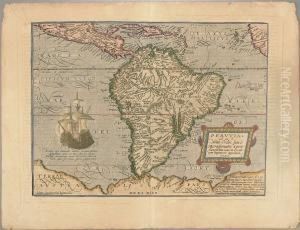Matthias Quad Paintings
Matthias Quad was a German engraver and cartographer during the late Renaissance period, notable for his contributions to the field of geography and map-making. Born in 1557 in Deventer, Netherlands, which was then part of the Holy Roman Empire, Quad initially began his career as an engraver and printer. Over time, he developed a strong interest in geography and map-making, which were rapidly evolving fields during the 16th century due to the Age of Discovery and the increased interest in exploration and colonization.
Quad moved to Cologne, which was a hub for scholars, artists, and scientists, and there he became associated with some of the leading cartographers of his time, including Abraham Ortelius and Gerard Mercator. His work was influenced by these interactions, and he became part of the vibrant intellectual community that was pushing the boundaries of cartographic knowledge and technique.
Throughout his career, Quad published several atlases and geographic works. One of his notable works is the 'Europae totius orbis terrarum', an atlas of Europe published in 1592. He also produced a collection of maps titled 'Geographisch Handtbuch' in 1600, which contributed to the dissemination of geographical knowledge. His work was characterized by detailed engravings and a commitment to incorporating the latest information available from explorers and other cartographers.
Quad's maps were not only functional but also works of art, featuring elaborate decorative elements such as sea monsters, ships, and ornate cartouches. These embellishments reflected the Renaissance fascination with both science and art, and they helped to make maps coveted items among the wealthy and educated classes of the time.
Matthias Quad passed away in 1613, leaving behind a legacy of important cartographic works that would influence the field for years to come. His maps remain valuable historical documents, providing insight into the state of geographical knowledge and the art of map-making during the Renaissance era.
